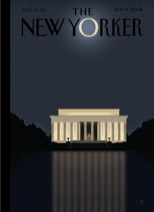OBAMA/NIELSEN
posted by James Reel
This week’s New Yorker cover by Bob Staake is especially striking for the way it blends several common images into an immediately recognizable message, even if that message is a bit hard to articulate. Bear with me, because this post will really be about music, but first look at the image:

That glowing building, of course, is the Lincoln Memorial, which all Americans should be able to identify even without seeing the sculpture of Lincoln inside (which you can’t, really, in this illustration). Overhead, the O in “New Yorker” has been transformed into a softly glowing moon, but it also evokes the O that Barack Obama used as his logo during the presidential campaign:

The implied message: The long night in America for people of African ancestry has nearly ended, a century and a half after Abraham Lincoln ended slavery, with the election of Barack Obama to the presidency.
This got me to thinking about how difficult it can be to craft a message like this through music. You’d think it would be easy; Bob Staake, for his illustration, selects, organizes and layers various symbolic images to create an implicit message, and the same technique should be available to composers through the manipulation of melodies. But it rarely works out that way.
When the technique has been attempted at all, it’s usually merely an act of placing two pre-existing themes in direct opposition to simulate warring nations: think of Beethoven’s Wellington’s Victory, with its conflicting French and English military tunes, or Tchaikovsky’s 1812 Overture. Of course, Charles Ives was a master of musical collage, but when he piled half a dozen popular American songs and marches upon each other in different meters, tempi and dynamics, he was simply evoking, say, the sounds in a park at night, with music drifting in from various locations. Ives was composing musical landscapes, not really telling a coherent story or making a philosophical point.
Film composers do this routinely, of course, establishing themes to represent specific characters or places or even issues, then manipulating them to underline the complexities of the scene at hand. But right now I’m more interested in concert-hall composers who can’t lean on the crutch of cinematic visuals.
The obvious place for a working-out of symbolic musical themes is the development section of a symphony, sonata or chamber work. Generally, the composer has laid out two or more distinct themes, and then rips them apart and knocks pieces of them against each other before putting things back in order for a recapitulation of the themes more or less in their original form. But this is a very abstract process. Composers may try to create a more concrete message by appropriating melodies that people know from other contexts, but somehow this usually sounds hokey. And if the composers use wholly original material, the themes really have no meaning for listeners beyond the context of the work at hand.
Yet one big exception came immediately to my mind, and you can probably think of a few others. The first movement of Carl Nielsen’s Symphony No. 5 does exactly what Bob Staake does on that New Yorker cover, but with entirely original motifs. Think about the climax in the development of the symphony’s first movement, a grand conflict between three distinctive motifs: an oppressive snare drum motto, a nattering and strident woodwind figure, and a broad, noble hymn. Nielsen wrote this shortly after World War I, and although he did not attach specific meaning to each theme, it’s difficult not to hear this as an explicit war symphony, in which the better angels of our nature (the hymn theme) overcome the destructive forces (which have been overcome, but not eliminated; the snare drum withdraws into the distance at the end, never fully surrendering).
So I’d say that the Nielsen Fifth is a fairly good analog for what’s going on with that New Yorker cover. Do you have other ideas?






